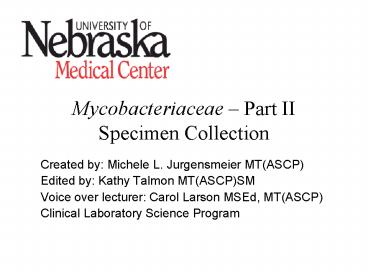Mycobacteriaceae - PowerPoint PPT Presentation
Title:
Mycobacteriaceae
Description:
Koneman, Color Atlas and Textbook of Diagnostic Microbiology, 5th Ed., J.B. Lippincott Co., 1997 Murray PK, et al., Manual of Clinical Microbiology, ... – PowerPoint PPT presentation
Number of Views:31
Avg rating:3.0/5.0
Title: Mycobacteriaceae
1
Mycobacteriaceae Part IISpecimen Collection
- Created by Michele L. Jurgensmeier MT(ASCP)
- Edited by Kathy Talmon MT(ASCP)SM
- Voice over lecturer Carol Larson MSEd, MT(ASCP)
- Clinical Laboratory Science Program
2
Specimen Collection
- Sterile disposable container
- Collect before antibiotic therapy
- Deliver promptly to laboratory
- Refrigerate if delay in delivery
- Swabs not acceptable in most laboratories
3
Specimen Types
- Respiratory - sputum, induced sputum, BAL
- Urine
- Gastric lavage
- Feces (not accepted in most labs)
- Wound drainage
- Blood
- Body fluids
- Tissues
4
Respiratory Specimens
- Sputum, induced sputum and BAL
- Irregular and intermittent release of
mycobacteria into bronchial lumen - Recommend minimum of 3 to 5 early morning
specimens on consecutive days - 10 mL or less per 50 mL tube
- NO pooled specimens
5
Urine Specimens
- 3 to 5 early morning midstream or catheterized
specimens - Entire volume or minimum 15 mls
- Centrifuge to concentrate specimen
6
Gastric Lavage
- Obtained when unable to obtain sputum samples
- Preferred specimen for children
- Must neutralize acids in specimen
7
Feces
- NOT acceptable for culture
- Some institutions do accept this specimen
- Immunocompromized patients (AIDS)
- Risk for disseminated mycobacterial disease
8
Aspirated Wound Drainages
- Fluid collected
- Swabs not acceptable
9
Blood Cultures
- Lysis centrifugation
- Release intracellular mycobacteria
- Concentrate organisms if present
- Or inoculate directly to broth media
- Direct inoculation to solid media should not be
done
10
Sterile Body Fluids
- Sterility strictly maintained
- Centrifuge and plate sediment
- CSF
- Large volumes needed
- Difficult to diagnosis tuberculous meningitis
11
Tissues
- Sterility strictly maintained
- Saline added to avoid dehydration
- In the lab, tissue is ground to release organisms
12
In review
- Specimen collection
- Mycobacteria isolated from variety of specimens
- Most common respiratory
- Sterile technique in collecting body fluids and
tissue - Concentrate specimens since mycobacteria may be
present in small numbers
13
References
- Mahon, C.R. Manuselis, G., Textbook of
Diagnostic Microbiology, 2nd Ed., W.B. Saunders,
2000 - Forbes, B.A., Sahm, D. F., Weissfeld, A.S.,
Bailey and Scotts Diagnostic Microbiology, 11th
Ed., Mosby, 2002. - Koneman, Color Atlas and Textbook of Diagnostic
Microbiology, 5th Ed., J.B. Lippincott Co., 1997 - Murray PK, et al., Manual of Clinical
Microbiology, 7th ed., ASM Publishing, Washington
DC, 1999.































